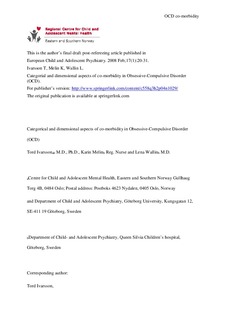Categorical and dimensional aspects of co-morbidity in obsessive-compulsive disorder (OCD)
Journal article
Permanent lenke
http://hdl.handle.net/11250/2386778Utgivelsesdato
2008Metadata
Vis full innførselSamlinger
Originalversjon
European Child and Adolescent Psychiatry 2008, 17(1):20-31 10.1007/s00787-007-0626-zSammendrag
Objective:
Obsessive-compulsive disorder (OCD) defined at the diagnostic level encompasses divergent symptoms and is often associated with other psychiatric problems. The present study examines OCD versus co-morbid symptom patterns in OCD in children and adolescents in order to investigate the presence of diagnostic heterogeneity.
Subjects and Methods:
A total of 113 outpatients with primary OCD participated. The patients’ and primary caretakers’ responses on semi-structured interviews (child version of Schedule for Affective Disorders and Schizophrenia and the Children’s Yale-Brown Obsessive Compulsive Scale) and parents’ responses on the Child Behaviour Checklist were used in the study. Psychiatric diagnoses were related to CBCL syndrome scores and CBCL scores were compared with the Swedish normative data.
Results:
Co-morbid diagnoses were very common and only one out of five patients had only OCD. The most common group was the neuropsychiatric disorders (47%) where tic disorders were most common (27%), especially among boys (40.8%; P = .006, Fisher’s exact test). Also anxiety disorders were common (39.8%) as were affective disorders (24.8%) neither with any gender differences. Diagnoses of disruptive disorders were less common (8.8%), almost exclusively of the oppositional kind (ODD) (8.8%). From the dimensional point of view using the CBCL, patients with OCD scored higher than Swedish youngster generally do, and some gender differences were seen in that girls scored higher on anxiety and depression while both girls and boys had high scores on thought problems, attention problems and especially aggressive behaviour. Comorbidities explained from 25 to 50% scores of the CBCL sub-syndrome scales, often with both main effects and through complex patterns of interaction with gender, OCD-severity and other co-morbid problems.
Conclusions:
While co-morbid problems is an important facet of OCD, sub-syndromal levels of symptoms that can be assessed using a dimensional approach, is a large part of the total symptom burden in these youngsters. Our data indicate contributions of different pathways for girls and for boys for several comorbid problems together with OCD-severity.
Beskrivelse
-
